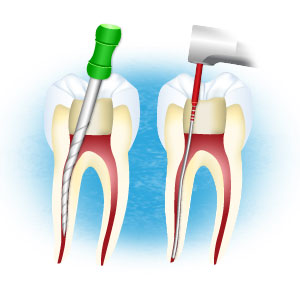Use of Non tapered LSX is a must for Apical Gauging

Why Apical zone is most important part of your Endodontic success
Apical third is a key determinant of your success in doing single visit Endododontics (more so in infected cases). Two things are important here- Apical Constriction (AC)
- Apical foramen (AF)
The AC is a natural barrier present in root canal systems and represents the termination point for endodontic instrumentation, irrigation and obturation.
AC can be accuratly determined with the use of Apex locator, and this is popularly known as WORKING LENGTH, radigraphs alone are not adequate for this purpose.
Apical gauging is done to determines to what size we need to instrument to get a clean apical region. Because most canals are curved you need a flexible and non tapered instrument to truthfully assess the correct diameter. LSX (LightSpeed from Sybron Endo) is the ONE and ONLY instrument which is capable of doing this for you*. Every tooth and every canal in each individual varies and can have range of sizes and no fixed guide is good for this purpose. If you want to instrument the canal based on science you MUST first determine what is the initial diameter, and this is known as WORKING WIDTH.
*NOTE - IF you do not have LSX, NiTi hand instrument (02 taper) is the second best choice.
It is a fact accepted in science that creating larger master apical diameter (MAD)is consistent with cleaner apical area. Even if you are a user of tapered NiTi rotary instruments, you can easily adopt Hybrid technique to achieve this objective -FULL TECHNIQUE
If the working width at start is size 25 and you finish treatment with F1 (tip size 20) then means that you have not even touched the walls of apical root canal, and there has been no cleaning and shaping in this critical area.
Recent micro-CT study by M.Marending,O.O.Schicht&F.Paque in 2011 published in IEJ evaluated the LSX for determining apical diameter. They concluded that Apical sizing instrument (LSX) with a flattened cross-section appears to be beneficial. They further noted that advocating enlarging the apical part of the root canal to three sizes larger than the IAF (initial apical file) which has been followed widely in the past does not stand the test of scientific investigation with modern aids like micro-CT . READ FULL PAPER
Two more studies given below clearly show that LightSpeed LSX is the instrument of choice for apical gauging.
An In Vivo Evaluation of Two Types of Files used to Accurately Determine the Diameter of the Apical Constriction of a Root Canal: An In Vivo Study Sumeet Darda, BDS, MDS; Narendra Manwar, BDS, MDS; Manoj Chandak, BDS, MDS; D. D. Shori, BDS, MDS
This study is published in July 2009 issue of Journal of Contemporary Dental Practice.It concluded:
The average size of the FLSB (First LightSpeed to Bind) to bind against the canal walls first at the working length was approximately two ISO sizes larger
than the FKFB (First K File to Bind) (P<0.001).
The initiation of canal instrumentation with a K-file size three sizes beyond the mean values of the FLSB will result in greater final enlargement of the canal compared to starting with the FKFB. This increased canal enlargement facilitates improved mechanical and chemical cleansing of the root canal ensuring removal of more microorganisms and their substrates, thus, improving the outcome of the treatment. Read Full paper
Using K file does not help you to give idea of correct apical size ...FULL STUDYComparison in vivo of the first tapered and nontapered instruments that bind at the apical constriction
Anda Kfir,Esther Rosenberg,Zvi Fuss, Triple O journal, Volume 102, Issue 3, Pages 395-398 (September 2006)To compare sizes of the first instrument with or without taper that binds to the narrow apical diameter of the root canal after coronal flaring.
For the study, 388 canals were examined in patients with intact apices. A standard endodontic access cavity was prepared and the coronal third flared using standardized K-files, Gates Glidden reamers, or Profile rotary instruments. Apical patency was established using K-file size 10 and working length determined using an apex locator and radiographs. Standardized K-file hand instruments were gently introduced to working length beginning with size 15. The first K-file to bind to the canal walls and reach the working length was recorded as FKFB. Nontapered instruments (Lightspeed) were then gently introduced by hand to each canal in ascending order beginning with size 20 to working length. The first instrument to bind to the canal walls and reach the working length was recorded as FLSB. Statistical analysis was carried out using univariate analysis of variance.
The average size of FLSB was approximately 2 ISO sizes larger than FKFB (P < .001). Minimal differences were found in the maxillary central incisors (6.7 ± 3.0) and maximal differences in canals from maxillary lateral incisors (15.4 ± 3.5).
The first nontapered instruments to bind at the apical constriction were larger and reflected the actual narrow apical diameter of the canal better than the tapered instruments.
So please use a non tapered instrument to do apical gauging if you want to follow science. Recent study published in the journal of Gen Dent in Sept-Oct 2007 by By Francis W. Allen clearly demonstrates that with tapered instruments you are able to clean only 18% of the apical 1 mm, it is because of body defenses that we still succeed in 70% cases. To download full paper CLICK HERE
Tweet